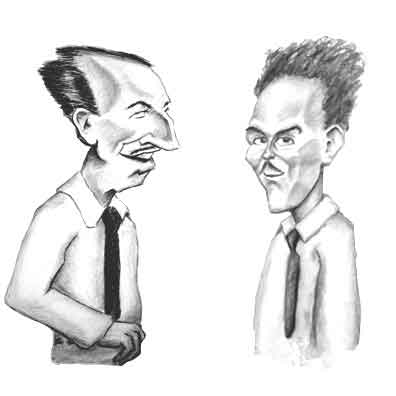Spike Jones

(Click on the image to zoom in.)
If you want to listen to some of Spike Jones's earliest recordings, just pull up certain selections of Judy Garland, Tony Martin, the Andrews Sisters, or Bing Crosby - and that includes Bing's White Christmas.
What is the meaning of all this? (To quote Goethe1). Judy, Tony, Maxene, Laverne, Patty, and Bing never used cowbells, washboards, whistles, spoons, anvils, car horns, and nutty vocals in their songs.
Footnote
The proper pronunciation of the surname of the German polymath Johann Wolfgang von Goethe is something like GUR-tuh, although when pronounced correctly it doesn't actually have the "r" sound. Another way to pronounce the German oe is to say a long American ee but while pursing your lips as if saying oo.
As to why the oe is not spelled with an umlut, ö, as is common in modern German, there's an easy answer. That's just the way Johann spelled it.
It must be stated most emphatically that the name is not pronounced GŌHTH with a long "o" and an English voiceless interdental "th". If you say that, German speakers will indignantly ask if it's all right for them to pronounce "Shakespeare" as shahk-es-PAH-ruh.
Well, no. But they did use drums. And before Lindley Armstrong Jones became the wildest and craziest of band leaders, he was a skilled percussionist and an in-demand session musician.
Spike was born in 1911 in Long Beach, California, but when he was ten weeks old, his folks, Lindley Murray Jones and Ada Armstrong, moved to the border town of Calexico. His dad worked as a railroad depot agent and the family lived in an apartment above the station.
The Jones family came from a line of Quakers, and according to one family member, Spike's dad was the first Quaker to use music in their religious services. Of course, today one of the few places you routinely hear live music is in churches. But in the early 20th century if you wanted good music it had to be live music. And since dancing was one of the most popular of leisure activities, the numerous ballrooms, dance halls, and road houses had to put up the cost for a house band. A kid who showed musical ability had a real shot at being a professional.
Spike started off learning to play trombone and piano but switched to drums when he was eleven. He became good enough that he was able to organize a Dixieland band called Spike Jones and His Five Tacks. They played for school dances and even made it onto the local radio stations. Spike took a brief hiatus from music when he attended Chaffey College but decided academics was not for him and quickly returned to his drumming.
Starting in 1929 and for the next ten years, Spike played in professional dance bands. Being from California was a plus since from the first years of the 20th century, the entertainment industry had been shifting away from New York to Hollywood which was a small municipality that was snuggled up with metropolitan Los Angeles. Opportunities for musicians had opened up, and by his mid-twenties Spike was making a steady living as a studio musician as well as playing in the house bands for major radio shows.
That a music group is largely defined by its members is a relatively new phenomenon. In fact, when Spike began playing there was nothing more ephemeral than a band's membership. After all, most musicians were independent businessmen who would work as contract workers as the jobs arose. So band personnel changed frequently - sometimes night to night - and many of the performers who would be part of a band for a tour, a radio show, or a recording session would also lead their own combos and orchestras.
The fluidity of membership, though, sometimes made it hard to tell who was the actual - quote - "leader" - unquote. You might find a recording of Miff Mole and the Eight Molers where the cornet player was Red Nichols. But then you'd pick up a recording of Red Nichols and his Five Pennies where the trombone player was Miff Mole. All the other slots would be filled in with other "leaders" with the likes of Benny Goodman, Jack Teagarden, and Bix Beiderbecke.
Leaders
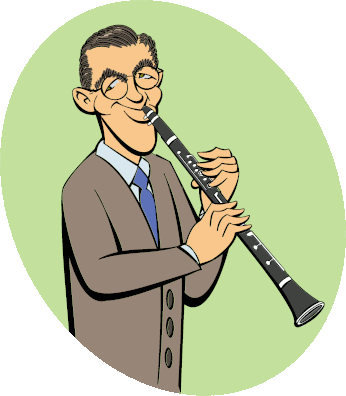
Benny

Jack
In 1939 Spike began playing in a band called the Feather Merchants whose nominal leader was Del Porter. Then at some point the Feather Merchants became the City Slickers although no one really remembered where the name came from or exactly when the transition was made. Del said he thought the name change was Spike's idea.
So the Feather Merchants/City Slickers had no well defined leadership. But to keep things organized at live performances the "leader" might be Del or singer and violinist Carl Grayson. But after one recording session held in August, 1941, and for reasons that are still unfathomable, one of the labels listed the band as "Spike Jones and His City Slickers".
The City Slickers started off as a regular dance band but soon began throwing in increasingly crazy humor in the act. Carl had the ability to make odd sounds when singing as well as being a master of dialects. Over the years Spike had also begun collecting various types of junk. These included anvils, wash basins, car horns, alarm clocks, telephones, and almost anything that could make a noise. With his formidable skills, he was able to bring these "instruments" into the performances.
Although it might seem that there wouldn't be much of a market for "spoof" songs, but starting in the 1910's there had been a new artistic genre taking over the country. This was the animated cartoon.
Of course, the rather humble Gertie the Dinosaur in 1911 was a silent film but with the advent of sound in films in the mid-1920's, there developed a demand for cartoon soundtracks with the occasional and whacky effects. Originally seen as something just for the kids, animation achieved artistic parity with other motion pictures in 1937 when Walt Disney's full-length animated version of Snow White and the Seven Dwarfs2 won an Academy Award. Then in 1942, the now iconic Bambi was released and picked up a Golden Globe.
Footnote
The usual plural of dwarf up to the 1960's was dwarfs as in the film's title. However, in J. R. R. Tolkiens' The Hobbit and The Lord of the Rings the plural was dwarves. When the books were released in paperback and became mass marketed, dwarves quickly became an acceptable variant although even today dwarfs is used more often.
In an appendix written for The Return of the King, the third volume of The Lord of the Rings, Ronald claimed he deliberately used the word "dwarves" as the plural of "dwarf" to "remove them a little, perhaps, from the sillier tales of these latter days". The "dwarves" in his books were actually a race of humans and were based on the common characters in folk mythology. Linguistically, he wrote, the plural would have better been dwarrows.
The reference to the "sillier tales" might have been a comment on Snow White but may very well have been a slight dig at the Narnia tales written by Ronald's friend, Clive Staples "Jack" Lewis. For some of the Narnia characters Jack had used the traditional "dwarfs". Ronald absolutely hated the Narnia tales.
Later Ronald admitted his use of "dwarves" was a simple mistake from analogy - leafs/leaves, wife/wives, loaf/loves - and he also used elves as the plural for elf rather than elfs. He invented his explanation in the appendix of The Lord of the Rings because he simply didn't want to own up that an Oxford English professor could make such a trivial error.
However, the word "dwarves" used as the plural of "dwarf" is found as early as 1808 although "dwarfs" is still used more often. "Elves", on the other had, has always been listed as a proper plural for "elf" and is now the most common spelling.
Of course, by 1942 there was also a war on. From 1939 to 1941, the grandson of Maria Schicklgruber had brought virtually all of Europe under German domination. At first the conflict was seen by some as just one more of those pesky "European wars" that had peppered history ever since the Middle Ages. But after the attack on Pearl Harbor, the United States' declared war on Japan on December 8, 1941, and Maria's grandson declared war on the US three days later. Suddenly the conflict was a World War. The second one, in fact.
The spittle-flinging carpet chewing former Chancellor of the Weimar Republic had always been a subject of satire and ridicule. So once Germany and the United States went to war, Walt Disney was now ready to take a swipe at the now self-dubbed Führer of Germany. Originally titled something like Donald Duck in Axis Land or Donald Duck in Nutziland the cartoon picked up an Academy Award and was the only Donald Duck cartoon to be so honored.
As the cartoon opens we disturbingly see Donald is living in Nazi Germany. He starts his day with a breakfast of stale bread and weak tea and heads off to work in a German war production factory for "48 hours a day (plus overtime)".3 Eventually Donald goes nuts due to the militaristic and regimented society with the never ending work only to wake up to find it was all a dream and he's overjoyed to be living in America, the Land of the Free and Home of the Brave.
Footnote
The duration of the work week during wartime Germany varies with the source. Certainly it changed as the war progressed and one source stated that a typical worker had a six day week of 10 hour days. The same source listed the US workers' week as 42 hours.
The action of the cartoon was crafted around the title song "Der Fuehrer's Face" played by a buffoonish band made up of caricatures based on Reichsminister Joseph Goebbels (trombone), President of the Emperor's Privy Council Hideki Tojo, (tuba), Reichsführer Heinrich Himmler (snare drum), Reichsmarschall Hermann Goering (piccolo), and Il Duce d'Italia Benito Mussolini (bass drum). The song was written by Oliver Wallace who was also the composer for the score of Disney's Dumbo.
As how the song made its way from the Disney Studios to Spike Jones and the City Slickers, there are three basic tellings. One story is that Oliver took the song to his neighbor, the pianist Carl Hoefle, who sometimes played for the Slickers. Naturally Carl showed the song to Spike and Del. Spike, on the other hand, insisted that he got the song from Nat Winecoff, a songwriter and singer turned businessman who also had worked with Disney.
Yet a third version was that Walt himself had decided to release the song as a separate recording in addition to its use in the cartoon. Not knowing who would be best to play such a song, someone in Walt's publicity department suggested Spike, and Walt gave his approval.
The song is pretty whacky as originally written and was a perfect venue for the City Slickers. They produced their own version for the record and also filmed a performance as a theatrical "short subject" - the precursor of that most lamentable of popular entertainments, the (bleah) music video.
Truth to tell, the cartoon version of the song is funnier, both musically and visually, than that released by the City Slickers. The Slickers' film was filmed in black and white with a single stationary camera and was mostly Carl singing in a comic-opera German accent with the other members crowded around. The only non-traditional instrument was Spike blowing through a rubber razzer to give a "raspberry" or "Bronx cheer".
But whoever recommended the song to Spike and whether the cartoon or the record is funnier, "Der Fuehrer's Face" moved Spike Jones and His City Slickers from their place as a moderately successful novelty band to musical stardom. They were immediately signed up as the house musicians for the Bob Burns Radio Show and were featured in the movie, Thank Your Lucky Stars.
After they released the song, Spike and the City Slickers, like other American musicians, stopped making new recordings until 1944. Nevertheless they performed for the troops and appeared in additional films. Then in 1945 they landed a weekly spot on the big time radio show The Chase and Sandborn Hour (yes, that's the actual name) which featured as guest stars the likes of Jimmy Durante, Edgar Bergen and Charlie McCarthy, W.C. Fields, Dorothy Lamour, Walter Winchell, Eddie Cantor, Don Ameche, and Mae West. Spike Jones and His City Slickers had become one of the biggest of big name entertainers.
Guest Stars
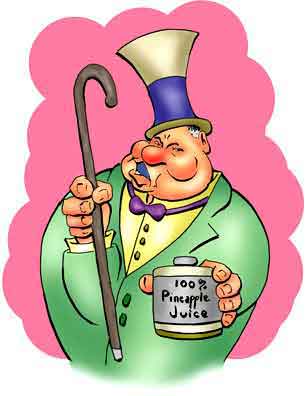
Bill

Walter
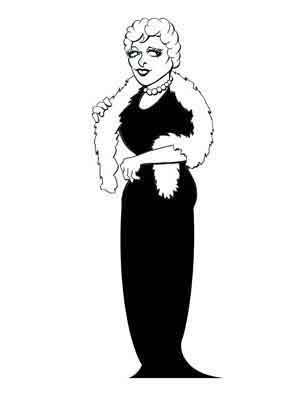
Mae
But after the war the times - to paraphrase a Nobel Prize winner - they were a-changing. There was a major shake-up in the band's personnel as most of the original band left. The famous comedian Doodles Weaver was brought in as was singer Helen Grayco, and new musicians filled the empty spots. Then in 1947 the City Slickers landed their own show, The Spotlight Revue which was soon redubbed The Spike Jones Show.
Some of Spike's defining recordings were produced soon after the war: "Cocktails for Two", "The Hawaiian War Chant" (today not quite politically correct), and his rendering of the "William Tell Overture". The latter song - much abbreviated from the original - features the famous "morning song", properly called the Ranz des vaches, played on banging garbage cans and a man gargling the melody. The iconic March of the Swiss Soldiers - ergo, the Lone Ranger theme song - is performed while an announcer calls a Hialeah-style horse race.
By the 1950's major changes were occurring not just in the music (such as the rise of be-bop jazz) but also in technology. By far the most significant advancement in music was the widespread availability of the long-playing or LP album. You could actually listen to a full TWENTY MINUTES of music without flipping the platter.
Nobel Laureate
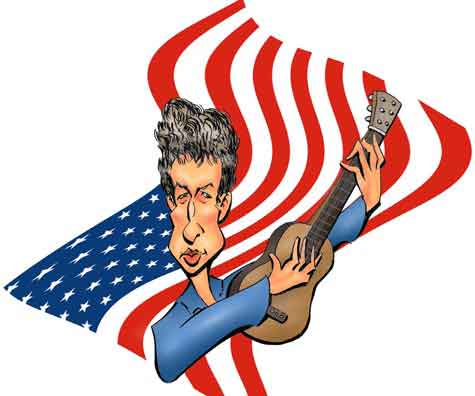
Before
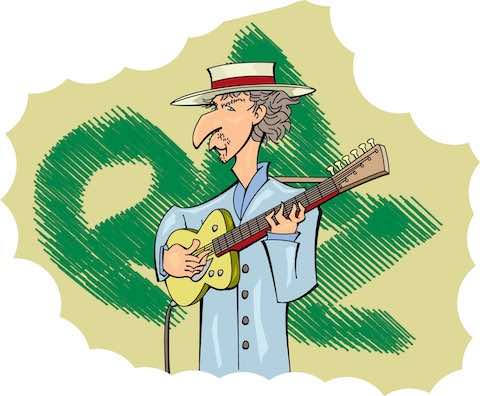
After
Among Spike's most famous albums was Dinner Music For People Who Aren't Very Hungry which featured liner notes by the Oscar winning composer Dimitri Tiomkin (High Noon, The Old Man and the Sea, The High and Mighty). Spike's songs, as Dmitri pointed out, required some of the best musicians available. Sometimes, though, the crazy music and vocals sometimes upstaged the skill of the performers.
Of course, with the arrival of the mid-century came the phenomenon that changed the world. That was television. The Spike Jones Show with its craziness was the perfect fit for the new visual medium. The show was on the air intermittently from 1954 to 1961, and among the cast was Bill Dana who played the famous character that he later said he regretted creating.
The performances of the City Slickers could be at a high frenzied and even maniacal pace, such as the "The Twelfth Street Rag" with an increasingly disassembled trombone, a musical tire pump, and what can only be called a tricranial clarinet. Or the songs could be relatively laid back - that's relatively laid back - like trombonist Tommy Pederson playing "Flight of the Bumblebee" interrupted by the accompanist's sneezes.
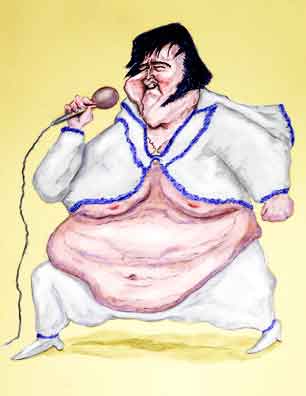
The Music the Parents Hated
As the Fabulous Fifties wore on and turned into the Swinging Sixties, Spike's popularity began to wane. Much of this was simply because as with any type of unique entertainment the novelty will eventually wear off. Spike's style of music, which was based on the big bands of the 30's and 40's, was also falling from favor with the younger bunch.

The English Invasion
Naturally the kids turned to the music their parents hated. That was rock and roll. It's not quite true that Spike couldn't satirize rock music - after all, everyone else did - but by the time the English invaded the United States in 1964, Spike was in poor health. As a three-pack-a-day man, Spike had to cut back his performing and died the following year, age 53.
